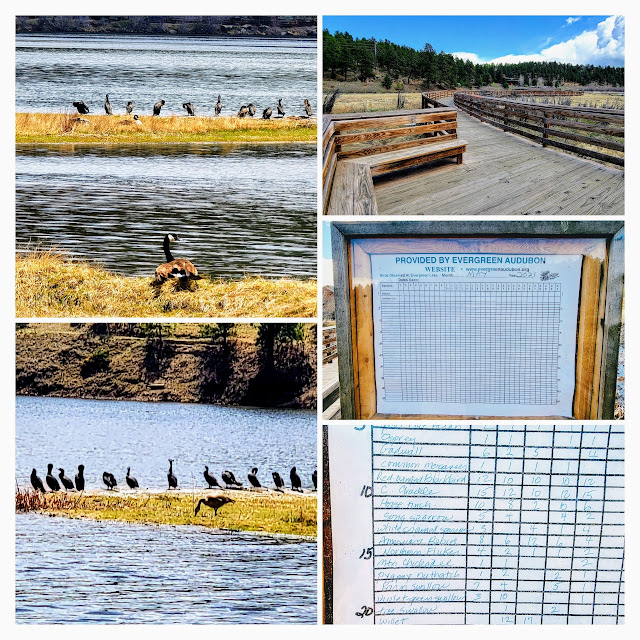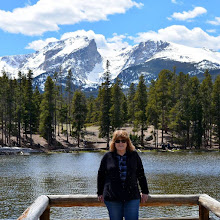Colorado bison
Years ago, after moving to Colorado, my husband and I would see a road sign driving west along Interstate 70, at exit 254, that said "Buffalo Herd Overlook." One day we traveled off that exit to finally see the herd. I did a blog post about it then--click here--to read that post. The road sign is incorrect as it is bison, not buffalo, that live protected at this Denver Mountains Parks preserve location. Though the terms are often used interchangeably, buffalo and bison are distinct animals. Old World “true” buffalo (Cape buffalo and water buffalo) are native to Africa and Asia. Bison are found in North America and Europe. Both bison and buffalo are in the Bovidae family, but the two are not closely related. Bison have large humps at their shoulders and bigger heads than buffalo. Bison also have beards, and thick coats which they shed in the spring and early summer. You can read more about the characteristics of the American bison at the Smithsonian's National Zoo and Conservation Biology Institute website here.

Happily, the state of Colorado maintains bison conservation preserves, many of which can be visited. You can see a list of some of these bison preserves on this link.
This year, by unanimous approval by the Denver City Council, Denver Parks and Recreation will begin donating bison from its herds to tribal nations and tribal nonprofit organizations. This first-of-its-kind gift provides 13 American bison to the Cheyenne and Arapaho Tribes, located in Oklahoma, and one bison to the Tall Bull Memorial Council in Colorado. All are female bison and many are expecting calves which will increase their herds.
This marks a change from the traditional surplus auction Denver held to keep its Genessee Park and Daniels Park bison herds at a healthy population and promote genetic diversity in managed herds across the nation. Now, instead of an auction, surplus animals will be donated to enhance the conservation of bison herds that also exist on tribal lands. The donation of bison will continue through the year 2030, in consultation with Denver Parks and Recreation's tribal partners, the Denver American Indian Commission, the Tall Bull Memorial Council, and the InterTribal Buffalo Council.
The bison may never roam freely, as they once did, but it is nice to think that their numbers will increase through these conservation efforts and that they will again flourish with the native people whom they sustained from the beginning of time!
An update to what is new in our days...
All my grandchildren are playing spring sports and we have been having fun watching soccer, lacrosse, and Little League baseball games. I saw this unusual cloud formation while at one of their games, and it reminded me of a "smoke signal" from the times of old. How far the world has come since then!
My husband and I had our first get together in over a year at a friend's house last week, along with other friends who are all fully vaccinated against covid. It was so good to see everyone in person and not to have to "gather" virtually on Zoom! My book club also had its first meeting in over a year that was not on Zoom. Thankfully, life is beginning to feel more normal again, and I know being able to go to outdoor activities in summer will help. I'm still remaining a bit cautious, as I know there are very contagious virus variants in many areas. Being vaccinated, however, has made me feel so much more at ease that I have some protection against hospitalization and death.
It has been such an unusual year but there is hope on the horizon. In the meantime, I hope you all stay happy and safe. Thank you for your visits to my blog and your comments--I appreciate them all!
You can also find me on
I'm linking this post to some of the following blog events:
Mosaic Monday, Blue Monday, Through My Lens Monday, Hearth, and Soul Link Party, You Are the Star Blog Hop, Inspire Me Monday, Home Matters Linky Party, Good Random Fun, Nature Notes, Grand Social, Travel Photos, Travel Tuesday, Happiness Is Homemade, Create, Bake, Make, Our World Tuesday, Ruby Tuesday, Tuesday Turn About. Tuesdays With A Twist, Let's Keep In Touch, Wordless Wednesday on a Tuesday, Party in Your PJ's, Wordless Wednesday, Nanahood WW, Oh My Heartsie Girl's Wonderful Wednesday, Your Whims Wednesday, Wednesday My Corner of the World, Wonderful Wednesday, Little Things Thursday, Thankful Thursday, Thursday Encouraging Hearts and Home, Thursday Thinking Out Loud, Friendship Fridays, Friday Features Linky Party, Skywatch Friday, Pink Saturday, Saturday Critters, Sunday on Silverado

























































